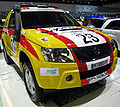2007 Suzuki Grand Vitara Owner's Manual - Page 159
2007 Suzuki Grand Vitara Manual
Page 159 highlights
INSPECTION AND MAINTENANCE Engine Coolant Replacement CAUTION • The mixture you use should contain 50% concentration of antifreeze. • If the lowest ambient temperature in your area is expected to be -35 °C (-31°F) or below, use higher concentrations up to 60% following the instructions on the antifreeze container. • When putting the cap on the reserve tank, line up the arrow on the cap and the arrow on the tank. Failure to follow this can result in coolant leakage. Open Close 66J191 66J151 WARNING Engine coolant is harmful or fatal if swallowed or inhaled. Do not drink antifreeze or coolant solution. If swallowed, do not induce vomiting. Immediately contact a poison control center or a physician. Avoid inhaling mist or hot vapors; if inhaled, remove to fresh air. If coolant gets in eyes, flush eyes with water and seek medical attention. Wash thoroughly after handling. Solution can be poisonous to animals. Keep out of the reach of children and animals. 1) When the engine is cool, remove the radiator cap by turning it slowly to the left until a "stop" is felt. Do not press down while turning the cap. Wait until any pressure is released, then press down on the cap and continue turning it to the left. WARNING It is hazardous to remove the radiator cap when the engine coolant temperature is high, because scalding fluid and steam may be blown out under pressure. Wait until the engine coolant temperature has lowered before removing the cap. 2) Remove the reservoir by lifting it up, and drain the reservoir completely. 9-18
















